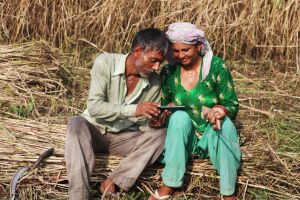Ensuring smallholder farmers receive agricultural information is of critical importance for realizing global food security, and the USDA has a prominent role to play in close partnership with USAID.
Executive summary
The United States extension system has underpinned the success of American farmers for over a century, and has helped bring the benefits of innovation and technology to even the most remote corners of rural America. Agricultural extension, alternatively referred to as rural advisory services, is the formal process of delivering information to farmers, particularly new techniques for production and harvesting, but also other information needed to flourish and compete in a fast-changing world.1 In the United States, extension is the mechanism that turns publicly funded university research and development (R&D) into actionable public goods, ensuring that discoveries at the country’s land-grant universities benefit all, particularly those in rural and agricultural communities. This model of tying research, extension, and teaching together in land-grant universities, empowered and shaped by local needs, enabled the United States to become a breadbasket for the world in the 20th century. This structure, combined with the community and youth-driven approach at the heart of agricultural extension, helped bring rural America into the modern age a century ago, and it has since inspired many countries around the world to replicate or adapt this approach.
As extension enters its second century and the digital age, farming and rural landscapes have changed dramatically, and public extension must adapt accordingly. People are connected to information today in ways that were unimaginable at the genesis of the US extension program, and while digital innovations across the public and private sectors are moving ahead, they must go further to serve American agriculture. This will not only enable the US extension system to continue the work that has made US agriculture so successful, but it will create a modern-day model with tools that can be adapted abroad to support low-income countries that continue to struggle with food and nutrition insecurity.
At home and around the world, agricultural extension systems are delivering information through a variety of platforms, including those operated by public, private, nonprofit, and civil society entities. This “pluralistic” system demonstrates that a range of approaches and actors can and should coexist. Indeed, in the United States the private sector plays an important role in disseminating data and information to farmers who can afford it. Innovative companies meet a variety of needs for advanced farming practices, from agronomic advice to farm management and risk mitigation in the face of global market dynamics. However, investment in US public extension continues to be critical for the health of the entire agricultural system as well as for certain segments of farmers and rural people that would otherwise be more marginalized. To ensure that innovations and advances in the research lab reach all those who could benefit, the extension system must comprehensively leverage digital technology.
Among the US extension system’s missions is to provide America’s diverse farmers with cutting-edge advice, whether to a large family farmer who is weighing a conversion to conservation agriculture practices, or to a millennial who is just starting an urban farming operation. The internet, mobile phone applications, and social media platforms are increasingly the first place the general public looks for information, including farmers. The same will be true for poor, small-scale farmers in low-income countries who are increasingly reached by data-enabled smartphones with access to popular search engines and social networking applications. The nature of learning is also shifting: crowd-sourced information, peer-to-peer exchange, and on-demand learning are hallmarks of the current age.
Embracing digital innovation in extension offers three key benefits, whether in the United States or abroad. First, it offers a chance to aggregate vast, complex agricultural information on a scale previously unachievable and then customize it for individual farmers to use at their convenience.
Second, digital innovation allows information to reach further—to more remote and marginal areas. In the age of Skype and Twitter, the number of farmers a single agent can reach in the span of a day by car or motorcycle will be a historical constraint.
Third, digital innovation can help contain or reduce overall costs, especially when it comes to reaching new farmers. Not only can digital technology scale at lower costs, it can also provide new and adaptive means of accounting for the time, effort, and success of extension agents and their programs, allowing public resources to be spent more efficiently with better performance data.
The day-to-day work of the rural advisory services will increasingly rely on innovations and good practices in the technology sector to help harness the vast information now available. If farmers are to remain globally competitive, a modern extension agent must remain grounded in local needs while making sense of the best available data and information from around the globe. Rather than “extending” information out from one center of expertise, agents now sit amidst a wide and multidirectional river of information. They are the experts that will help farmers find what they need and decipher increasingly larger volumes of data. Embracing digital innovation allows for a shift in perception of agricultural extension, which may create new appeal among young talent. These “digital natives” entering the workforce are exploring ways to contribute their skills toward critical challenges at home and abroad. Employment as an extension agent could be appealing for both its compelling mission and room to innovate.
American innovation and leadership in digital agricultural advisory services will be critical to continued US agricultural competitiveness. And, innovation in agricultural extension has the potential to serve as a catalyst in ending food insecurity and poverty around the world. But the full power of these services is still being unlocked.
A three-pronged approach to harnessing the power of digital technology can spark great progress at home and contribute to global food security abroad. First, thoughtful review and targeted investments at the national level, paired with incentives that reward innovation across the county, state, and regional tiers, will position the United States to leap forward. Second, new public-private partnerships with a range of technology, data, and agricultural companies as well as with social enterprises at the forefront of digital technology present new opportunities to harness innovations for extension and expand access for underserved populations. And third, greater innovation in domestic extension should be twined with greater emphasis on innovation within US foreign assistance activities, as outlined in the US Global Food Security Strategy. This could be achieved by leveraging existing activities on the ground and within capacity-building exchange programs, while focusing on harmonized data collection and learning across partners.
Ensuring smallholder farmers receive agricultural information is of critical importance for realizing global food security, and the United States Department of Agriculture (USDA) has a prominent role to play in close partnership with USAID. Beyond this, however, the mission of scaling up modern access to agricultural information for food security also creates greater opportunity to rely on the expertise of land-grant universities, the Cochran and Borlaug Fellowships, the John Ogonowski and Doug Bereuter Farmer-to-Farmer program, and returning volunteers from the Peace Corps.




